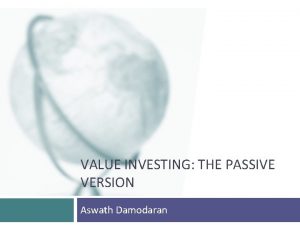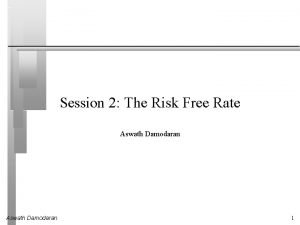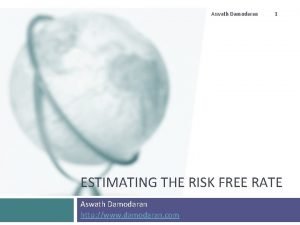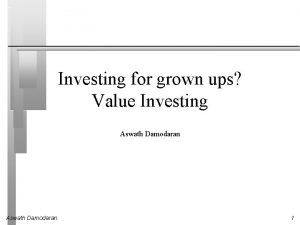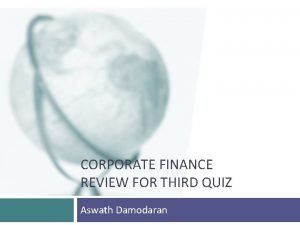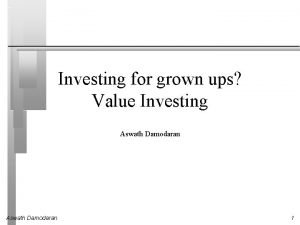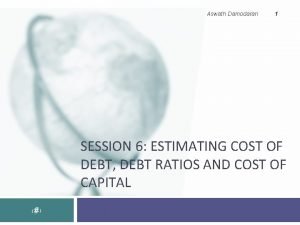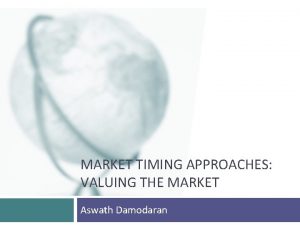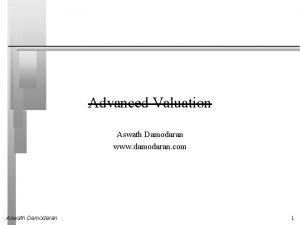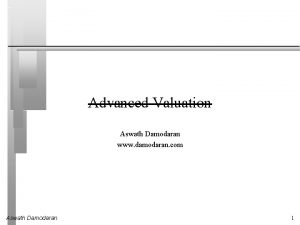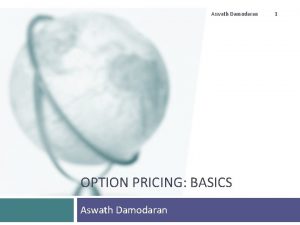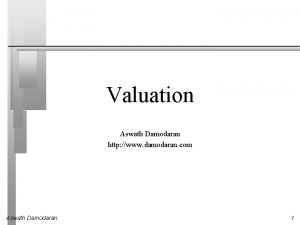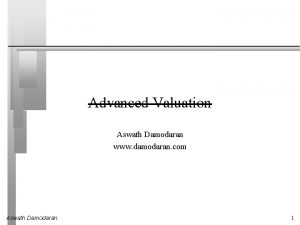Market Timing Approaches Valuing the Market Aswath Damodaran














- Slides: 14

Market Timing Approaches: Valuing the Market Aswath Damodaran

Valuation Approaches • Just as you can value individual stocks with intrinsic valuation (DCF) models and relative valuation (multiples) models, you can value the market. • If you have faith in your market valuations, you would view it as under valued if it is at a level lower than predicted by your intrinsic or relative value models.

I. Intrinsic Value: Valuing the S&P 500 • On January 1, 2011, the S&P 500 was trading at 1257. 64 and the dividends plus buybacks on the index amounted to 53. 96 over the previous year. • On the same date, analysts were estimating an expected growth rate of 6. 95% in earnings for the index for the following five years. Beyond year 5, the expected growth rate is expected to be 3. 29%, the nominal growth rate in the economy (set equal to the risk free rate). • The treasury bond rate was 3. 29% and we will use a market risk premium of 5%, leading to a cost of equity of 8. 29%. (The beta for the S&P 500 is assumed to be one)

Valuing the index • We begin by projecting the cash flows on the index, growing the cash flow (53. 96) at 6. 95% each year for the next 5 years. • Incorporating the terminal value, we value the index at 1307. 48.

How well do intrinsic valuation models work? • Generally speaking, the odds of succeeding increase as the quality of your inputs improves and your time horizon lengthens. Eventually, markets seem to revert back to intrinsic value but eventually can be a long time coming. • There is, however, a significant cost associated with using intrinsic valuation models when they find equity markets to be overvalued. If you take the logical next step of not investing in stocks when they are overvalued, you will have to invest your funds in either other securities that you believe are fairly valued (such as short term government securities) or in other asset classes. In the process, you may end up out of the stock market for extended periods while the market is, in fact, going up. • The problem with intrinsic value models is their failure to capture permanent shifts in attitudes towards risk or investor characteristics. This is because so many of the inputs for these models come from looking at the past.

Relative Valuation Models • In relative value models, you examine how markets are priced relative to other markets and to fundamentals. • While it shares some characteristics with intrinsic valuation models, this approach is less rigid, insofar as it does not require that you work within the structure of a discounted cashflow model. • Instead, you either make comparisons of markets over time (the S&P in 2010 versus the S&P in 1990) or different markets at the same point in time (U. S. stocks in 2010 versus European stocks in 2002).

1. Comparisons across Time

More on the time comparison… • This strong positive relationship between E/P ratios and T. Bond rates is evidenced by the correlation of 0. 6854 between the two variables. In addition, there is evidence that the term structure also affects the E/P ratio. • In the following regression, we regress E/P ratios against the level of T. Bond rates and the yield spread (T. Bond - T. Bill rate), using data from 1960 to 2010. E/P = 0. 0266 + 0. 6746 T. Bond Rate - 0. 3131 (T. Bond Rate-T. Bill Rate) R 2 = 0. 476 (3. 37) (6. 41) (-1. 36) • Other things remaining equal, this regression suggests that – Every 1% increase in the T. Bond rate increases the E/P ratio by 0. 6746%. This is not surprising but it quantifies the impact that higher interest rates have on the PE ratio. – Every 1% increase in the difference between T. Bond and T. Bill rates reduces the E/P ratio by 0. 3131%. Flatter or negative sloping term yield curves seem to correspond to lower PE ratios and upwards sloping yield curves to higher PE ratios.

Using the Regression to gauge the market… • We can use the regression to predict E/P ratio in November 2011, with the T. Bill rate at 0. 2% and the T. Bond rate at 2. 2%. E/P 2011 = 0. 0266 + 0. 6746 (. 022) - 0. 3131 (. 022 -. 02) = 0. 0408 or 4. 08% • Since the S&P 500 was trading at a multiple of 15 times earnings in November 2011, this would have indicated an under valued market.

2. Comparisons across markets

Example 2: An Old Example with Emerging Markets: June 2000 11

Regression Results • The regression of PE ratios on these variables provides the following – PE = 16. 16 - 7. 94 Interest Rates + 154. 40 Growth in GDP - 0. 1116 Country Risk R Squared = 73% 12

Predicted PE Ratios 13

Determinants of Success at using Fundamentals in Market Timing • This approach has two limitations: – Since you are basing your analysis by looking at the past, you are assuming that there has not been a significant shift in the underlying relationship. As Wall Street would put it, paradigm shifts wreak havoc on these models. – Even if you assume that the past is prologue and that there will be reversion back to historic norms, you do not control this part of the process. . • How can you improve your odds of success? – You can try to incorporate into your analysis those variables that reflect the shifts that you believe have occurred in markets. – You can have a longer time horizon, since you improve your odds on convergence.
 Aswath damodaran value investing
Aswath damodaran value investing Damodaran default spread
Damodaran default spread Default spread damodaran
Default spread damodaran Damodaran statistics
Damodaran statistics Aswath damodaran multiples
Aswath damodaran multiples Aswath damodaran discount rate
Aswath damodaran discount rate Aswath damodaran value investing
Aswath damodaran value investing Damodaran discount rates
Damodaran discount rates Quiz
Quiz Damodaran portfolio
Damodaran portfolio Types of investment philosophies
Types of investment philosophies Aswath damodaran website
Aswath damodaran website Aswath damodaran value investing
Aswath damodaran value investing Damodaran interest coverage ratio
Damodaran interest coverage ratio Aswath damodaran intrinsic value
Aswath damodaran intrinsic value
